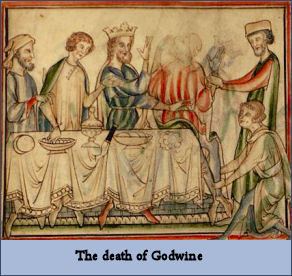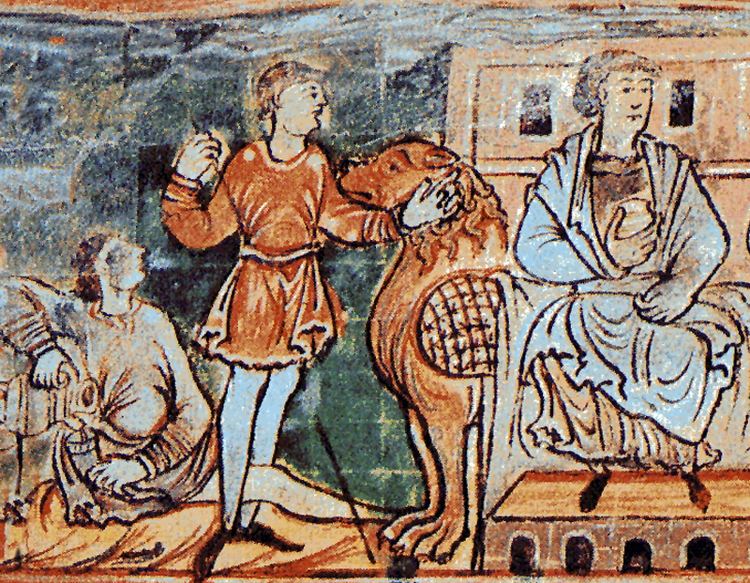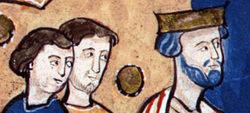Reign 1020–1053 | Name Godwin, of Parents Wulfnoth Cild | |
 | ||
Issue Sweyn, Earl of HerefordshireHarold II, King of EnglandTostig, Earl of NorthumbriaEdith, Queen of EnglandGyrth, Earl of East AngliaLeofwine, Earl of KentWulfnothAlfgarEdgivaElgivaGunhilda House House of Godwin (founder) Children Harold Godwinson, Tostig Godwinson, Edith of Wessex Similar People | ||
Godwin earl of wessex
Godwin of Wessex (Old English: Godƿin; 1001 – 15 April 1053) was one of the most powerful earls in England under the Danish king Cnut the Great and his successors. Cnut made him the first Earl of Wessex. Godwin was the father of King Harold Godwinson and Edith of Wessex, wife of King Edward the Confessor.
Contents
- Godwin earl of wessex
- Rise to power
- Height of power support of Harold
- Later conflicts decline and death
- Children
- Legacy
- References

Rise to power

Godwin's father was probably Wulfnoth Cild, who was a thegn of Sussex. His origin is unknown but 'Cild' normally refers to a man of rank. In 1009 Wulfnoth was accused of unknown crimes at a muster of Æthelred the Unready's fleet and fled with twenty ships; the ships sent to pursue him were destroyed in a storm. Godwin was probably an adherent of Æthelred's eldest son, Æthelstan, who left him an estate when he died in 1014. This estate in Compton, Sussex, had once belonged to Godwin's father. Although he is now always thought of as connected with Wessex, Godwin had probably been raised in Sussex, not Wessex and was probably a native of Sussex.

After Cnut seized the throne in 1016, Godwin's rise was rapid. By 1018 he was an earl, probably of eastern Wessex, and then by around 1020 of all Wessex. Between 1019 and 1023 he accompanied Cnut on an expedition to Denmark, where he distinguished himself, and shortly afterwards married Gytha, the sister of the Danish earl, Ulf, who was married to Cnut's sister, Estrid.
Height of power: support of Harold
On 12 November 1035, Cnut died. His kingdoms were divided among three rival rulers. Harold Harefoot, Cnut's illegitimate son with Ælfgifu of Northampton, seized the throne of England. Harthacnut, Cnut's legitimate son with Emma of Normandy, reigned in Denmark. Norway rebelled under Magnus the Noble. In 1035, the throne of England was reportedly claimed by Alfred Ætheling, younger son of Emma of Normandy and Æthelred the Unready, and half-brother of Harthacnut. Godwin is reported to have either captured Alfred himself or to have deceived him by pretending to be his ally and then surrendering him to the forces of Harold Harefoot. Either way Alfred was blinded and soon died at Ely.
In 1040, Harold Harefoot died and Godwin supported the accession of his half-brother Harthacnut to the throne of England. When Harthacnut himself died in 1042 Godwin supported the claim of Æthelred's last surviving son Edward the Confessor to the throne. Edward had spent most of the previous thirty years in Normandy. His reign restored the native royal house of Wessex to the throne of England.
Later conflicts, decline, and death
Despite his alleged responsibility for the death of Edward's brother Alfred, Godwin secured the marriage of his daughter Edith (Eadgyth) to Edward in 1045. As Edward drew advisors, nobles and priests from his former place of refuge in a bid to develop his own power base, Godwin soon became the leader of opposition to growing Norman influence. After a violent clash between the people of Dover and the visiting Eustace II, Count of Boulogne, Edward's brother-in-law, Godwin was ordered to punish the people of Dover (as he and Leofric, Earl of Mercia had done in Worcester, in Leofric's own earldom). This time, however, Godwin refused, choosing to champion his own countrymen against a (visiting) foreign ruler and his own king. Edward saw this as a test of power, and managed to enlist the support of Siward, Earl of Northumbria and Earl Leofric. Godwin and his sons were exiled from the kingdom in September 1051. Godwin, along with his wife Gytha and sons Sweyn, Tostig and Gyrth sought refuge in Flanders, while his sons Leofwine and Harold fled to Dublin, where they gained the shelter and help of Diarmait mac Máel na mBó, King of Leinster. They all returned to England the following year with armed forces, gaining the support of the navy, burghers, and peasants, so compelling Edward to restore his earldom. This however set a precedent to be followed by a rival earl some years later, and then by Godwin's own son, Tostig, in 1066.
On 15 April 1053 Godwin died suddenly, after collapsing during a royal banquet at Winchester. According to one colourful account by the 12th-century writer Aelred of Rievaulx, Godwin tried to disclaim responsibility for Alfred Ætheling's death with the words "May this crust which I hold in my hand pass through my throat and leave me unharmed to show that I was guiltless of treason towards you, and that I was innocent of your brother's death!". He swallowed the crust, but it stuck in his throat and killed him. However, this appears to be no more than Norman propaganda, contemporary accounts indicating that he just had a sudden illness, possibly a stroke. According to the Abingdon version of the Anglo-Saxon Chronicle, under the year 1053: "On Easter Monday, as he was sitting with the king at a meal he suddenly sank towards the footstool bereft of speech, and deprived of all his strength. Then he was carried to the king's private room and they thought it was about to pass off. But it was not so. On the contrary, he continued like this without speech or strength right on to the Thursday, and then departed this life."
His son Harold succeeded him as Earl of Wessex, an area then covering roughly the southernmost third of England. With the death of Earl Siward (1055) and later Earl Ælfgar (1062), the children of Godwin were poised to assume sole control. Tostig was helped into the earldom of Northumbria, thus controlling the north. The Mercian earl was sidelined, especially after Harold and Tostig broke the Welsh-Mercian alliance in 1063. Harold later succeeded Edward the Confessor and became King of England in his own right in 1066. At this point, both Harold's remaining brothers in England were earls in their own right, Harold was himself king and in control of Wessex, and he had married the sister of Earl Edwin of Mercia and Morcar, Earl of Northumbria (who had replaced Tostig). Godwin's family looked set to inaugurate a new royal dynasty, but instead Harold was overthrown and killed in the Norman Conquest.
Children
Legacy
It is sometimes claimed that the Goodwin Sands off the coast of Deal in Kent owe their name to Earl Godwin; that they were once an island owned by him, but that the sea washed the island away in 1097. However, no such island is mentioned in Domesday Book, which was compiled in 1085-86, nor is there any geological evidence for its existence, and Goodwin has been alternatively explained as an ironic name for a dangerous shoal, deriving from the Old English for "good friend".
Godwin has been portrayed by Torin Thatcher in the film Lady Godiva of Coventry (1955), by Norman Rodway in the BBC TV series Churchill's People (1974–75), and by Bill Wallis in an episode of the British educational TV series Historyonics entitled "1066" (2004). Godwin is also the lead character of Justin Hill's novel, Shieldwall (2011).
